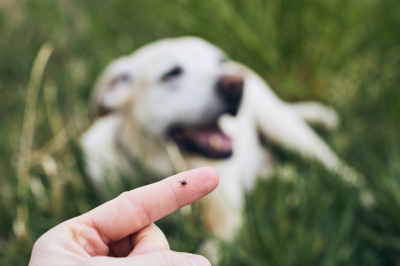
The Companion Animal Parasite Council released its 2022 Pet Parasite Forecast and the details will certainly bug you. Tick populations are on the rise, and they are spreading to new territories, meaning the disease-causing bacteria they carry are, too. Most concerning to people and pets are the tick vectors for Lyme disease (black-legged or deer tick in North America, castor bean tick in Europe). As the weather warms up and we begin to spend more time outdoors, these ticks are also transitioning from their winter dormant phase, hidden in the leafy debris, to their active feeding phase.
Lyme disease is transmitted to dogs through the bite of an infected tick. Once in the bloodstream, the bacteria that cause Lyme disease (Borrelia burgdorferi) are carried to many parts of the body and commonly localize in the joints and kidneys. Not all deer ticks and castor bean ticks carry the bacteria that causes Lyme disease, but certain geographical areas have been identified as higher risk. Check with your veterinarian or local public health department to find out if you live in a high-risk area.
In dogs, signs of Lyme disease can take two to five months to appear. Lameness and joint pain, especially in the knee and elbow joints, are often the first signs noticed with Lyme disease. This lameness may shift from leg to leg or may occur intermittently. Dogs may also develop a fever. In some cases, the disease resolves on its own but, in others, it may be long-term and can affect the kidneys and heart, resulting in death. Some dogs don’t have any obvious signs, so yearly testing for Lyme disease, along with heartworm testing, is highly recommended.
While there is treatment available for Lyme disease, it can be difficult to treat, especially if it isn’t caught early. Prevention is always easier than treatment.
You can help protect your pet from becoming infected with Lyme disease by:
- using a tick preventive
- avoiding wooded or grassy areas and stick to trails
- performing daily tick checks and removing any ticks that you may find (see below)
- discussing the Lyme vaccine with your veterinarian for dogs living in high-risk areas
Many different tick preventives are available and some also contain ingredients that can protect your dog from certain intestinal parasites and/or heartworm. The most effective preventives are those prescribed by your veterinarian. Your veterinarian will help you choose which preventive is best suited for your dog’s health and lifestyle.
Check your pets daily for ticks, especially if you live in a high-risk area. Give your dog a full once over but be sure to focus on the following areas: in and around the ears, around the eyelids, under the collar, between the toes, around the tail, between the back legs, and between the front legs. If you find a tick on your pet, it’s important to remove it right away.
The bacteria that cause Lyme disease can pass through small cuts or wounds in your skin, so be sure to wear disposable gloves when removing ticks. If you find a tick attached to your pet, grasp it with tweezers near his skin and firmly pull it straight out. Pull the tick with even, steady pressure—it may take a minute or two for the tick to release its grip. If you are unable or unsure of how to remove the tick, or if the tick’s body breaks away from its head, leaving the head in the skin, contact your veterinarian for advice.
Dogs cannot transmit Lyme disease to one another or to humans, as the infection always comes directly from a tick bite. If a dog in your area tests positive for Lyme, however, it means infected ticks are nearby and you should exercise caution for both yourself and your pets.